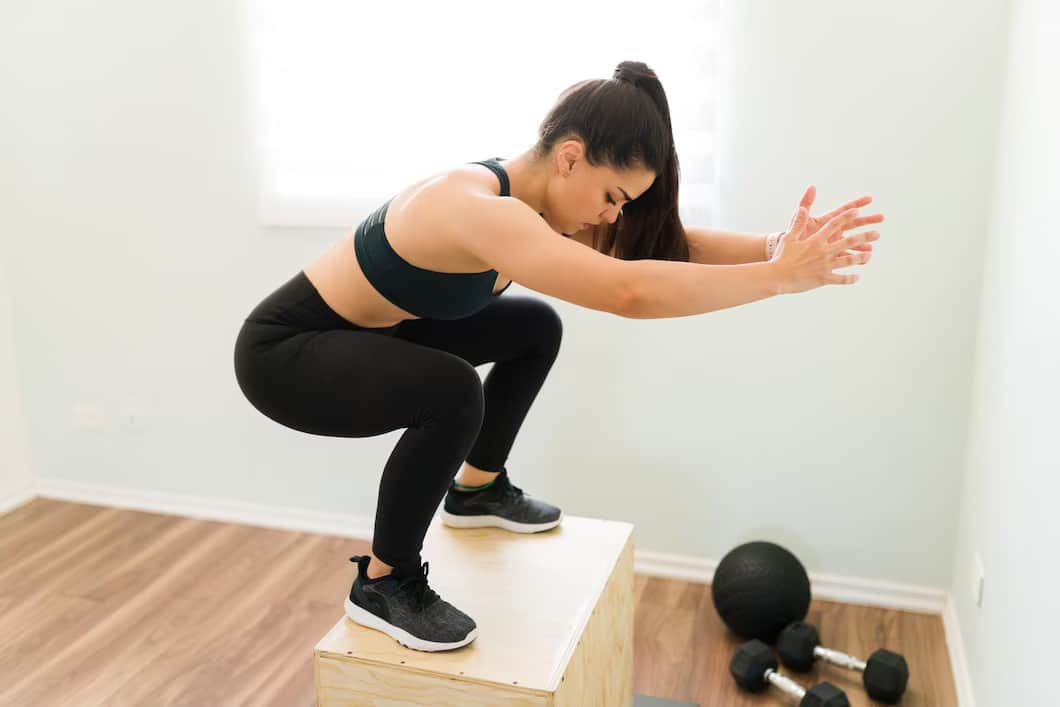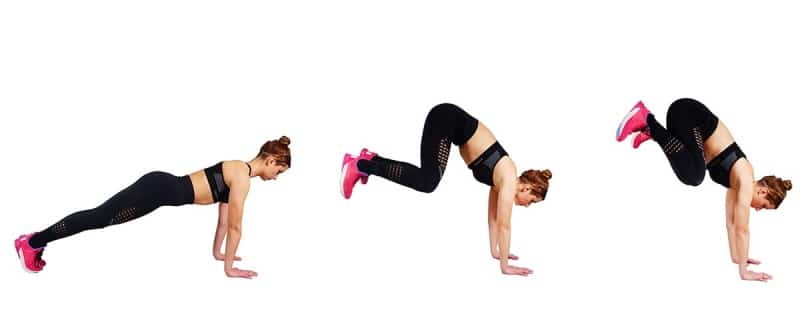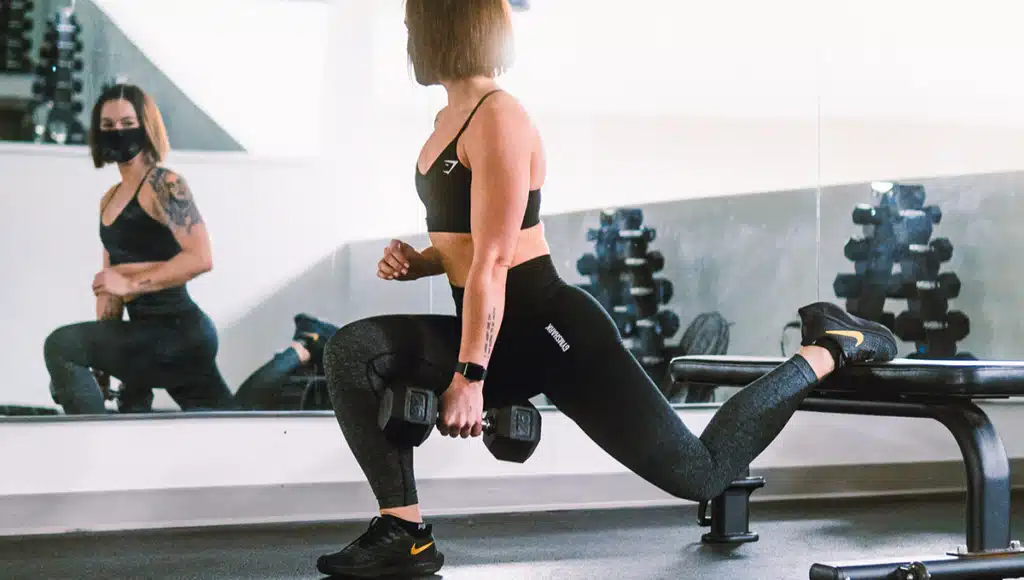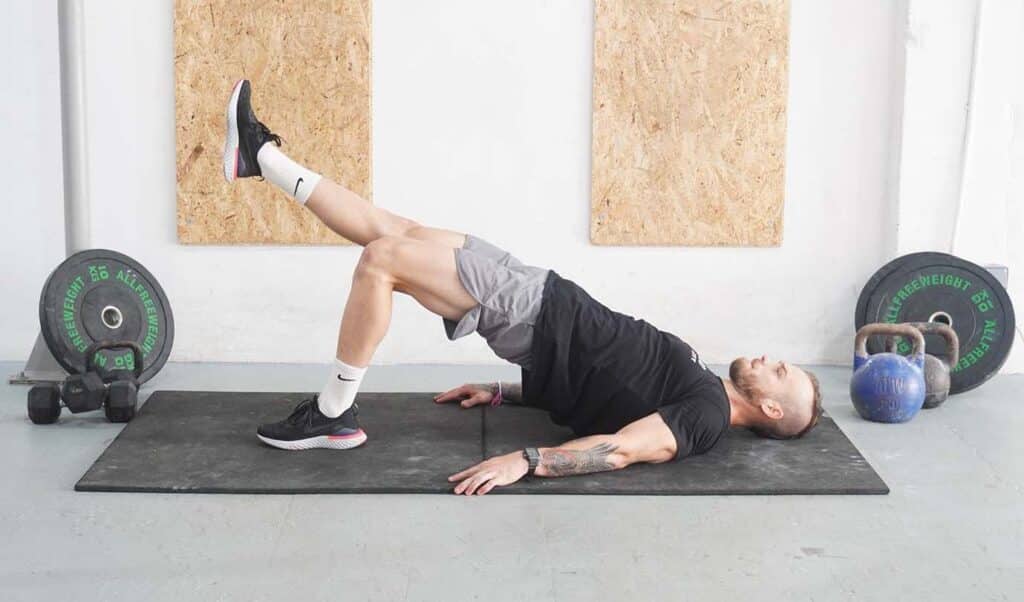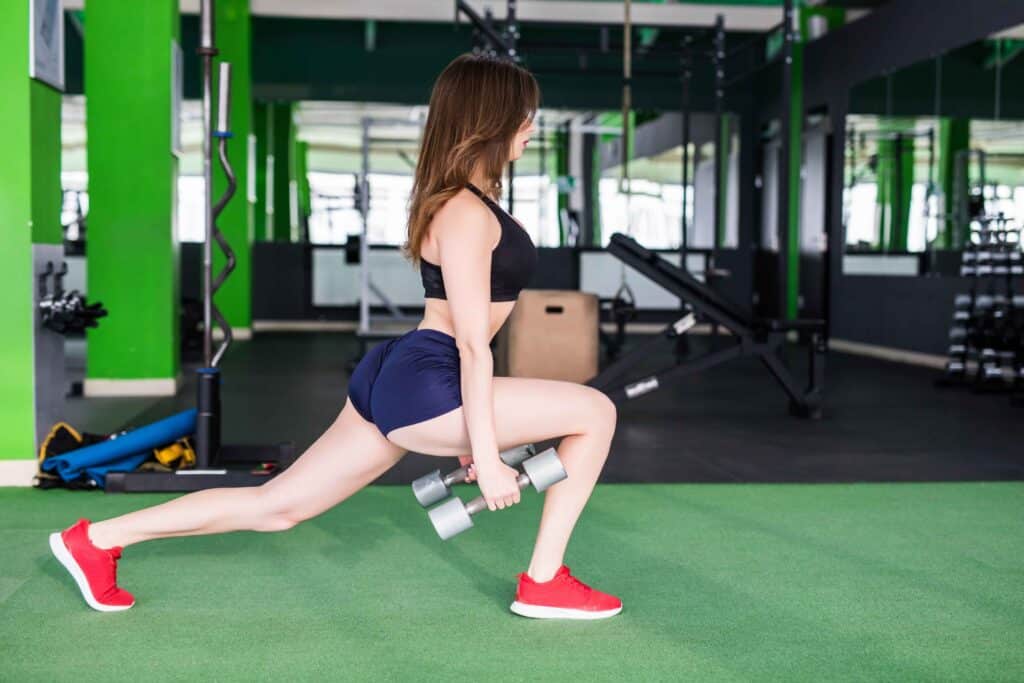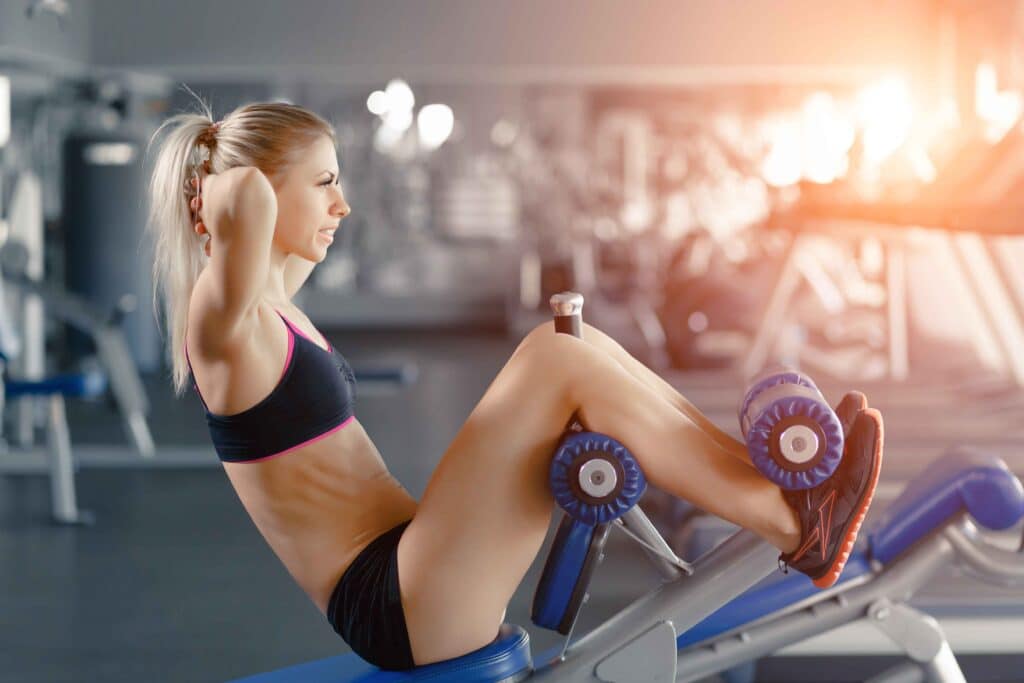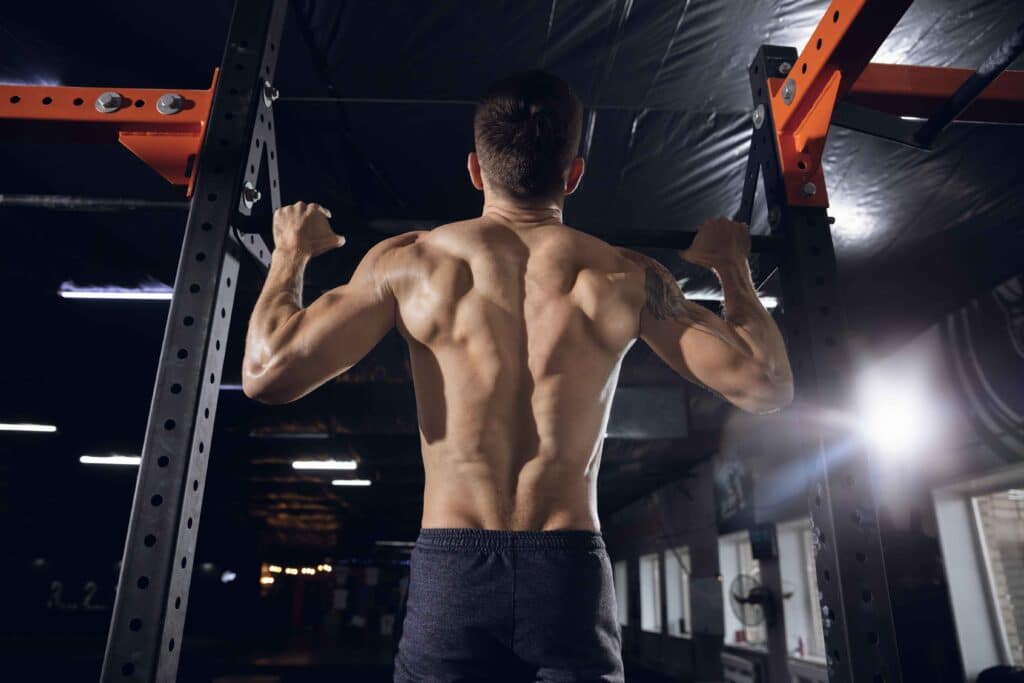Are you having a tough time targeting your glutes with traditional exercises? If so, don’t be discouraged—sometimes, the solution is not to work harder but smarter.
That’s why we recommend trying compound glute exercises for extra oomph in your next training session.
Compound movements are like warfare: they attack multiple muscle groups from different angles at the same time and deliver maximum impact.
In this post, you’ll learn all about how combining certain moves can help fire up your glutes and take your fitness results to the next level.
So, without any further delay, let’s get things moving:
Best Compound Glute Workout
Let’s take a look at some of the most result-driven compound glute exercises that will shape your buttocks at will:
1. Frog Kick
Frog kicks are a great compound exercise that targets the glutes, core, and hip flexors. It’s an effective movement to strengthen and tone your glute muscles.
It specifically targets the glute muscles, including the gluteus maximus, medius, and minimus, which are responsible for hip extension and abduction.
By engaging the glutes during the kick motion, you can effectively tone and shape these muscles, giving your buttocks a more sculpted appearance.
Step-By-Step Guide:
- Starting position: Lie down on your back on an exercise mat or flat surface. Place your hands by your sides, palms facing down. Keep your legs straight and together, toes pointing upward, and heels hovering slightly above the ground.
- Frog position: Bend your knees outwards, bringing the soles of your feet together. Keep your knees as close to the ground as comfortably possible. This position should resemble the shape of a frog’s legs.
- Engage your core: Gently tighten your core muscles by drawing your belly button towards your spine. This will help stabilize your lower back throughout the exercise.
- Perform the kick: Inhale as you lower your legs towards the ground, maintaining the frog position. Lower them only as far as you can without lifting your lower back off the mat or feeling any discomfort. Exhale as you squeeze your glutes and use your hip muscles to lift your legs back to the starting position.
- Controlled motion: Keep the movement slow and controlled throughout the exercise. Avoid using momentum to swing your legs up, as it may reduce the effectiveness of the exercise and increase the risk of injury.
- Repetitions and sets: Start with 10-12 repetitions for beginners, and gradually increase the number of reps as you become more comfortable with the exercise. Aim for 2-3 sets with a short rest between sets.
2. Bulgarian Split Squats
While the quads are the primary focus, Bulgarian Split Squats also engage the glutes, helping to improve overall lower body strength and shape.
Bulgarian Split Squats allow you to isolate and work each leg individually, which helps correct muscle imbalances between the left and right sides of the body.
The exercise predominantly targets the quadriceps (front thigh muscles), making it an excellent choice for strengthening and toning the legs.
Step-By-Step Guide:
- Starting position: Stand facing away from a bench or elevated surface, such as a step or sturdy chair. Take a step or two forward with one foot (the one you’ll be working on) and place the top of your other foot (the non-working leg) on the bench behind you.
- Stance: Position your feet at hip-width or slightly wider for better stability. Keep your chest up, shoulders back, and engage your core throughout the exercise.
- Descend into the squat: Inhale as you bend your front knee and lower your body down into a lunge position. Lower your body until your front thigh is parallel to the ground, or your knee is at a 90-degree angle. Your back knee should be hovering just above the floor.
- Proper form: Ensure that your front knee is directly above your ankle and doesn’t extend beyond your toes. Your back leg should form a 90-degree angle at the knee. Keep your upper body upright throughout the movement.
- Ascend from the squat: Exhale as you push through your front heel to return to the starting position. Maintain control throughout the movement, especially on the way up.
3. Step-Ups
Step-ups must be on your list of effective lower body exercises that primarily target the glutes, quadriceps, and hamstrings. It also improves balance, stability, and cardiovascular endurance.
This compound glute exercise is excellent for targeting and activating the glute muscles, which helps in toning and shaping your buttocks.
It challenges your balance and stability, as you have to control the movement while stepping up and down. This is beneficial for improving overall balance and proprioception.
Step-By-Step Guide:
- Starting position: Stand in front of the bench with your feet shoulder-width apart. Keep your back straight, shoulders back, and engage your core for stability.
- Step-up: Step onto the bench with your right foot first. Push through your right heel, engage your glutes and quadriceps, and lift your body up onto the bench.
- Full extension: Once your right foot is on the bench, straighten your right leg completely at the top, standing tall on the bench with both feet. Your left foot should be lifted slightly off the ground.
- Balance: Take a brief moment to balance on the top of the bench, ensuring stability and control.
- Step down: Carefully step back down with your left foot first, followed by your right foot, returning to the starting position.
- Alternate legs: Repeat the exercise, this time leading with your left foot. Step onto the bench, fully extend your left leg, and then step back down.
- Repetitions and sets: Aim for 10-15 repetitions on each leg for 2-3 sets. You can increase the intensity by holding dumbbells or weights in your hands while performing the exercise.
4. Single-Leg Glute Bridge
The single-leg glute bridge specifically targets the glute muscles, helping to strengthen and tone them effectively.
By performing this glute compound exercise on one leg, you engage the stabilizing muscles of the hips and core, improving your balance and stability.
This exercise helps address any strength disparities between the two sides of your body as you work each leg independently.
Step-By-Step Guide:
- Starting position: Lie down on your back on an exercise mat or flat surface. Bend your knees, keeping your feet flat on the ground, hip-width apart. Place your arms by your sides, palms facing down.
- Lift one leg: Extend one leg straight out in front of you, keeping it parallel to the ground. This will be your working leg throughout the exercise.
- Engage your core: Gently tighten your core muscles by drawing your belly button towards your spine. This will help stabilize your lower back during the movement.
- Lift your hips: Inhale as you press through your grounded foot and drive your hips upward towards the ceiling. Focus on using your glutes and hamstring muscles to lift your hips, while keeping your upper back and shoulders on the ground.
- Single-leg position: As you lift your hips, your body weight should be supported by your grounded foot and your shoulders. Your extended leg should be in line with your torso, forming a straight line from your shoulders to your knee.
- Glute squeeze: At the top of the movement, pause for a moment and squeeze your glutes tightly. This will intensify the activation of your glute muscles.
- Lower down: Exhale as you slowly lower your hips back to the starting position, maintaining control throughout the movement.
- Repeat on the other side: Complete the desired number of repetitions on one leg before switching to the other leg.
5. Weighted Lunges
Weighted lunges are an excellent compound exercise for targeting the glutes, quadriceps, hamstrings, and core.
Adding weights to the lunges increases the resistance, making it a more challenging and effective exercise for building strength and muscle in the lower body.
Lunges mimic everyday movements, such as walking or climbing stairs, making them a functional exercise for improving lower body strength.
Step-By-Step Guide:
- Starting position: Stand tall with your feet hip-width apart and your arms down by your sides, holding a dumbbell in each hand.
- Posture: Engage your core and maintain an upright posture throughout the exercise. Keep your shoulders back, chest lifted, and gaze forward.
- Step forward: Take a controlled step forward with your right leg, ensuring your heel lands first, followed by your toes. The length of your step should be comfortable and not too wide to maintain balance.
- Lunge position: As you step forward, lower your body towards the ground by bending both knees. Your right knee should form a 90-degree angle, with your thigh parallel to the floor, and your left knee should be hovering just above the ground.
- Glute engagement: Focus on engaging your glutes as you push through your right heel to return to the starting position. The glutes play a crucial role in bringing your body back up to a standing position.
- Alternate legs: Step forward with your left leg and repeat the lunge on the other side. Continue alternating legs for the desired number of repetitions.
- Repetitions and sets: Aim for 8-10 repetitions on each leg for 2-4 sets. If you’re new to weighted lunges, start with a lighter weight and gradually increase as you build strength and confidence.
Recap
Summing up, we have discussed all about compound glute exercises and how they can be a game-changer due to their intensity.
So what are you waiting for? Go break a sweat and strengthen those glutes.
These workouts will definitely amp up your core strength without any doubt.
Keep coming back in touch with this blog section of Lifter’s Digest which is full of health tips, nutrition info and tricks to stay fit no matter who or where you are. All it takes is passion and dedication.
Don’t just dream – Execute.

